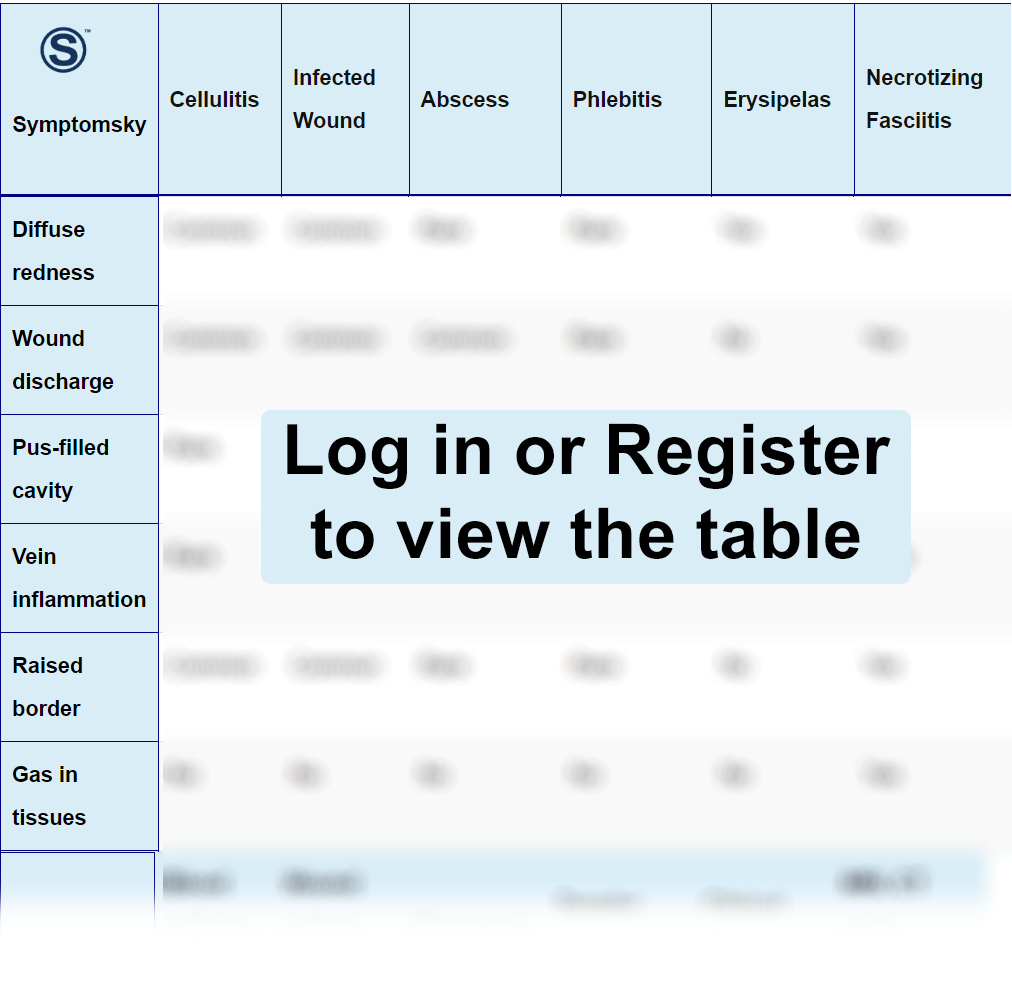Contents
- 1 Wound Swelling Differential Diagnosis Table:
- 2 How to Recognize Which Disease Is Causing Wound Swelling
- 2.1 How to Recognize if Cellulitis Is Causing Wound Swelling
- 2.2 How to Recognize if an Infected Wound Is Causing Wound Swelling
- 2.3 How to Recognize if Abscess Is Causing Wound Swelling
- 2.4 How to Recognize if Phlebitis Is Causing Wound Swelling
- 2.5 How to Recognize if Erysipelas Is Causing Wound Swelling
- 2.6 How to Recognize if Necrotizing Fasciitis Is Causing Wound Swelling
- 3 Common Red Flags with Wound Swelling
Wound Swelling Differential Diagnosis Table:

The skin is the organ that is most extensively in contact with the external environment and therefore acts both as a mechanical protective barrier and as an immune organ which initiates and controls various immune responses. Wounds are very frequent and are the result of the disruption of the skin surface due to a variety of factors including animal bites, surgical procedures, burns, and falls.
The wound healing course involves three partially simultaneous phases: inflammation, proliferation, and tissue remodeling. This process will vary based on the size and location of the wound.
Wound swelling is the immune system’s response to localized damage. This induces local erythema, warmth, and pain and only subsides when cellular debris or any type of foreign body present is removed from the wound. In other words, it is a normal response of the immune system to exogenous cell death or tissue injury that is essential to restore homeostasis and repair the affected tissue.
How to Recognize Which Disease Is Causing Wound Swelling
How to Recognize if Cellulitis Is Causing Wound Swelling
Cellulitis is an infection at the level of the deep dermis subcutaneous cellular tissue in which there is not always an entrance door (superficial wound), consisting of a very poorly demarcated erythematous plaque, not warm to the touch and not painful. Also, it is accompanied by systemic symptoms such as chills, fever, and fatigue.
How to Recognize if an Infected Wound Is Causing Wound Swelling
Wounds get infected when bacteria enter the wound and multiply. These bacteria can originate from circulating skin, the exterior, or the object that caused the injury. Wound swelling is accompanied by extreme pain, redness, edema, local warmth, presence of exudate, hypergranulation, bad odor, cellulitis, leukocytosis, and systemic symptoms such as pyrexia and fatigue.
How to Recognize if Abscess Is Causing Wound Swelling
Swelling of the abscess is accompanied by elementary lesions, which are erythematous accumulated nodules of pus, painful to the touch, with local warmth. The patient can also present with fever.
How to Recognize if Phlebitis Is Causing Wound Swelling
Phlebitis is the inflammation or swelling of a vein accompanied by irritation. The vein is hard and painful to the touch. The patient’s medical history is connected to the presence of phlebitis, and lifestyle is also involved as the patient spends much time in the same standing or sitting position, also if it has coagulation alterations.
How to Recognize if Erysipelas Is Causing Wound Swelling
Erysipelas is an infection that affects the superficial dermis and is characterized by well-demarcated erythematous plaques, not painful to the touch, with warmth. It is also accompanied by systemic symptoms such as fever and chills. It has very frequent sequelae that can support the diagnosis, such as pigmentation disorders, scarring, and lymphedema.
How to Recognize if Necrotizing Fasciitis Is Causing Wound Swelling
Necrotizing fasciitis is an infection of the fascia covering the muscles of a limb or the trunk. It has an acute onset with severe pain at the affected site, fever, prostration, and rapid deterioration of the patient’s general condition. Visually, there are no inflammatory signs at the beginning, but patients report pain on palpation. Within hours, the symptoms will worsen, and there is a dark erythema or mottling with the presence of edema and skin anesthesia, as well as the presence of gas in deep cutaneous tissues.
Common Red Flags with Wound Swelling
If for any reason these symptoms intensify or are added to others such as delayed healing, wound odor, cavitations, lymphangitis, pyrexia, exudate, general malaise, we would be facing signs of a local or disseminated infection.
Certain patients are more susceptible to a poor response to a wound healing process: elderly patients, diabetic patients, patients with alterations in the immune system, or with lesions in the central nervous system. It is important to control inflammation in these patients with appropriate dressings to facilitate the healing course.
